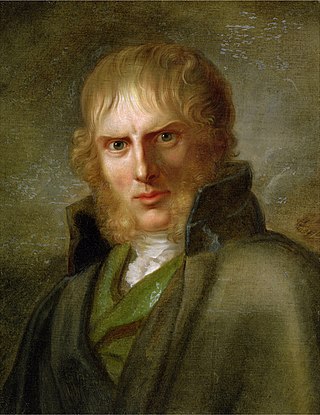
Caspar David Friedrich was a 19th-century German Romantic landscape painter, generally considered the most important German artist of his generation. He is best known for his mid-period allegorical landscapes, which typically feature contemplative figures silhouetted against night skies, morning mists, barren trees or Gothic ruins. His primary interest was the contemplation of nature, and his often symbolic and anti-classical work seeks to convey a subjective, emotional response to the natural world. Friedrich's paintings characteristically set a human presence in diminished perspective amid expansive landscapes, reducing the figures to a scale that, according to the art historian Christopher John Murray, directs "the viewer's gaze towards their metaphysical dimension".

Wanderer above the Sea of Fog is a painting by German Romantic artist Caspar David Friedrich made in 1818. It depicts a man standing upon a rocky precipice with his back to the viewer; he is gazing out on a landscape covered in a thick sea of fog through which other ridges, trees, and mountains pierce, which stretches out into the distance indefinitely.

The Stages of Life is an allegorical oil painting of 1835 by the German Romantic landscape painter Caspar David Friedrich. Completed just five years before his death, this picture, like many of his works, forms a meditation both on his own mortality and on the transience of life.
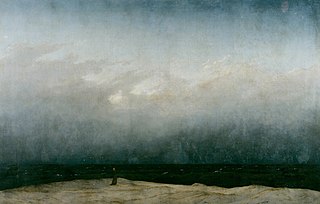
The Monk by the Sea is an oil painting by the German Romantic artist Caspar David Friedrich. It was painted between 1808 and 1810 in Dresden and was first shown together with the painting The Abbey in the Oakwood in the Berlin Academy exhibition of 1810. On Friedrich's request The Monk by the Sea was hung above The Abbey in the Oakwood. After the exhibition, both pictures were bought by king Frederick Wilhelm III for his collection. Today, the paintings hang side by side in the Alte Nationalgalerie, Berlin.
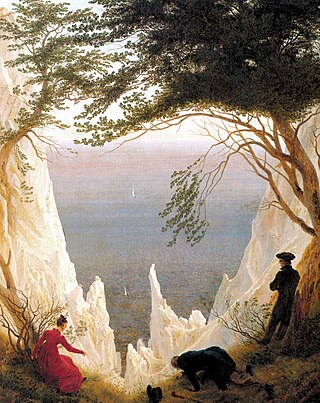
Chalk Cliffs on Rügen is an oil painting of circa 1818 by German Romantic artist Caspar David Friedrich.

The Abbey in the Oakwood is an oil painting by Caspar David Friedrich. It was painted between 1809 and 1810 in Dresden and was first shown together with the painting The Monk by the Sea in the Prussian Academy of Arts exhibition of 1810. On Friedrich's request The Abbey in the Oakwood was hung beneath The Monk by the Sea. This painting is one of over two dozen of Friedrich's works that include cemeteries or graves.

The Tree of Crows is an oil painting of 1822 by the German Romantic artist Caspar David Friedrich. Acquired by the Musée du Louvre in 1975, it has been called one of Friedrich's "most compelling paintings." The painting depicts a twisted oak tree, bare but for a few dead leaves, seen against an evening sky. An inscription on the back of the canvas refers to the hill at the painting's center as a Hünengrab, or dolmen, a prehistoric burial ground. In the distance can be seen the ocean, and Cape Arkona's chalk cliffs, a favorite subject of Friedrich's. Two crows are perched on the oak, while a flock descends toward it. In the darkened foreground are a hacked trunk and the upright stump of another oak.

Two Men Contemplating the Moon and Man and Woman Contemplating the Moon are a series of similar paintings by Caspar David Friedrich, the setting being among his best-known works. Friedrich painted at least three versions, with one variation featuring a man and a woman. The 1819–20 version in the Galerie Neue Meister is thought to be the original; the c. 1824 variant with a woman is in the Alte Nationalgalerie; and the c. 1830 version is in the Metropolitan Museum of Art.

Jupiter and Antiope is an oil painting by the French artist Antoine Watteau. It is also known as the Satyr and the Sleeping Nymph and was probably painted between 1714 and 1719. Intended to be placed over a doorway, today it hangs in the Musée du Louvre in Paris.
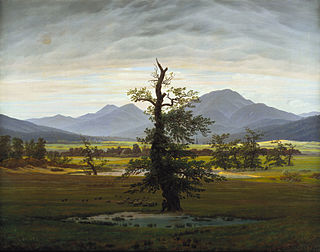
The Lonely Tree is an 1822 oil-on-canvas painting by German painter Caspar David Friedrich. It measures 55 × 71 centimetres (22 × 28 in). The work depicts a panoramic view of a romantic landscape of plains with mountains in the background. A solitary oak tree dominates the foreground.

Morning on the Riesengebirge is an 1810-1811 painting by Caspar David Friedrich of a scene on the Riesengebirge. It was exhibited at the Dresden Academy, where it attracted significant public attention. The painting was then acquired in 1811 by Frederick William III of Prussia for Unter den Linden, his Berlin palace, where it remained until 1837, when it was moved to the New Palace in Potsdam.
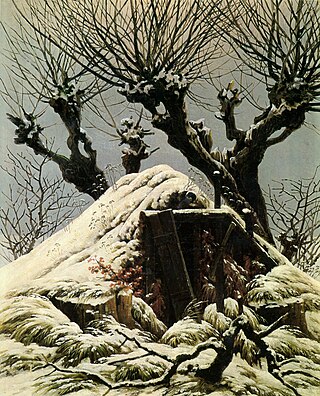
Cabin in the Snow or Cabin under Snow is an 1827 painting by Caspar David Friedrich, first exhibited at the exhibition held by the Dresden Academy of Fine Arts, from which it was acquired by John I of Saxony.

Two Men by the Sea is a painting by Caspar David Friedrich, first exhibited at the exhibition held by the Dresden Academy of Fine Arts in 1817, from which it was acquired a representative of mother superior Maria Richter of Berlin. It first appears in the inventories of the Nationalgalerie in 1936 as number A II 884. It was displayed at the Schloss Charlottenburg until 1967 and from 1986 to 2001 it was hung in the Schloss' Knobelsdorff wing. Since 2001 it has been displayed in the Alte Nationalgalerie in Berlin.

The Woman with the Spider's Web is a small 1803 print by the German Romantic painter Caspar David Friedrich, made into a woodcut the same year by his brother Christian Friedrich, a carpenter and furniture maker.

Evening is an 1821 oil on canvas painting by Caspar David Friedrich, now in the Niedersächsischen Landesmuseum Hannover. With Morning, Midday and Afternoon, it forms a series on different times of day.

River Bank in Fog is a c. 1821 oil on canvas painting by Caspar David Friedrich, now in the Wallraf-Richartz-Museum & Fondation Corboud in Cologne, for which it was acquired in 1942 from the Graf Hahn collection at Schloss Basedow (Mecklenburg). It is also known as Elbschiff in Early Fog.

The Gazebo or The Garden Bower is an 1818 oil on canvas painting by Caspar David Friedrich, now in the Neue Pinakothek in Munich.

The Great Enclosure or The Ostra Enclosure (Ostra-Gehege) is an 1831 oil on canvas painting by Caspar David Friedrich, now in the Galerie Neue Meister in Dresden, though it hangs in the Albertinum. It is known as the "crowning achievement of Friedrich's late work".

Hutten's Grave is an 1823 oil on canvas painting by Caspar David Friedrich, showing a man in Lützow Free Corps uniform standing by the grave of the Renaissance poet and humanist Ulrich von Hutten. It is now in the Klassik Stiftung Weimar's collection and on show in the Schlossmuseum at the Stadtschloss Weimar.

The Temple of Juno in Agrigento is an 1828-1830 oil on canvas painting of by Caspar David Friedrich. It is now in the Museum für Kunst und Kulturgeschichte in Dortmund, which bought it from a Cologne art dealer in 1951. It is said to have been previously owned by the F. A. Brockhaus publishers in Leipzig.






















